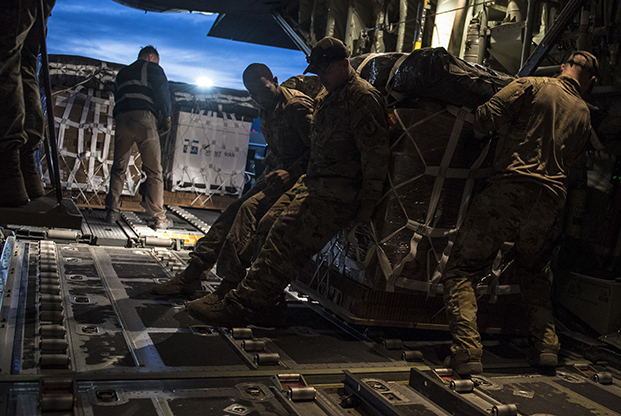
Aircrew members of a C-130J Super Hercules assigned to the 774th Expeditionary Airlift Squadron and a US Army soldier at Bagram Airfield, Afghanistan, pushes a load of supplies to inline with the cargo for a tactical airdrop to an undisclosed location in Afghanistan on April 20, 2018. Air Force photo by SrA. Xavier Navarro.
Last year was busier for US aircraft operating in Afghanistan than any year in at least a decade, with more strikes conducted in 2018 than the previous three years combined. At the same time, US aircraft rapidly increased operations against ISIS in Iraq and Syria.
In Afghanistan, US aircraft conducted 7,362 strikes in all of 2018, compared to just 4,361 last year, according to numbers released Friday by Air Forces Central Command. This comes as the US is meeting with the Taliban to discuss a “framework” toward peace and trying to build the Afghan Air Force to be self-sustaining in its fight.
US aircraft also saw a dramatic spike in airdrops in 2018 with 667,880 pounds—the equivalent of about 16 full C-130Js—dropped compared to just 33,423 last year.
US Army Gen. Joseph Votel, commander of US Central Command, told lawmakers the focus in Afghanistan is currently to “use military ways and means” to advance the end state of military force. US operations will not solely solve the conflict, but can help enable diplomatic efforts.
“While these efforts have had recent promise, our mission has not changed,” Votel told the Senate Armed Services Committee on Feb. 5. “We will continue our military pressure in support of our national objectives until they are met.”
USAF Maj. Gen. James Hecker, vice director of operations for the Joint Staff, told the House Armed Services Committee on Feb. 6 the military focus is to “keep the pressure on the Taliban” even as negotiations are ongoing.
“We’ve kind of made the distinction between Talibans,” he said. “There’s irreconcilable Taliban, which we don’t think will ever reconcile, and then there’s the others they’re talking about,” referring to leadership involved in negotiations. “What we need to do is keep pressure on the non-reconcilable Taliban to help the negotiations with the State Department.”
Hecker, who previously led air operations in Afghanistan as the commander of NATO Air Command-Afghanistan, told Air Force Magazine during a 2017 visit to Kabul that loosened rules of engagement, an increased presence of aircraft such as A-10s and refuelers in Kandahar, along with long-range bomber trips from elsewhere in CENTCOM, were enabling more strikes when needed.
Meanwhile, in Iraq and Syria, US and coalition aircraft conducted 2,214 airstrikes in December, the highest total in more than a year. While the year ended at an increase, the 2018 total of 8,713, which is much lower than the previous year’s total of 39,577.
This increase came the same time President Trump declared on Twitter that the US had defeated ISIS and would be withdrawing from Syria. Trump said earlier this week during a State Department meeting with members of the coalition a declaration that ISIS had been cleared from 100 percent of the land it once held would be coming soon and that US forces would be leaving Syria. An administration official said forces would be redeployed to neighboring Iraq to “keep a very close eye on ISIS.”
“There’s been a significant increase in airstrikes in both Syria, and Iraq, and Afghanistan,” Hecker said. “So, we’ve increased the efforts to decrease the physical caliphate and I think we’ve been relatively successful, as you’ve seen. There’s roughly only about 1 percent of the physical caliphate left and that’s in Syria and the Middle Euphrates Valley, and we are rapidly working to try to finish that off. And we think we’ll be there quite soon.”